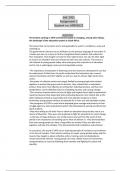SAE 3701
Assignment 2
Student no: 69992622
QUESTION 1
The Soweto uprising in 1976 contributed largely in changing, among other things,
the landscape of the education system in South Africa:
The lesson that can be learnt and is still applicable to youth is confidence, unity and
standing up.
The government's decision to use Afrikaans as the primary language of instruction in
schools was seen as a move to further marginalise black students and undermine
their education. They fought not only for their right to learn, but also for their right
to receive an education that was relevant to their lives and cultures. This lesson is
still relevant to young people today, who must grasp the importance of education
and its role in upbringing a more just and equitable society.
-The importance of education in fostering social and economic development can also
be understood. At that time, the youth understood that education was a way to
express themselves and their dignity, as well as a way to achieve high marks and a
career.
-the power of collective action was largely fuelled by young people who banded
together to protest the government's decision, they realised that as individuals
protest, they were more effective at uniting than individual protest, and that civil
disobedience can be effective tools for combating injustice and causing change.
-Their activism inspired others to join the fight and helped shed a light on apartheid's
injustices because they stayed put when protesting became more violent due to the
police failing to provide a responsible and more peaceful response to them
protesting. young people continue to advocate for a more just and equitable society.
-the youngsters of 1976 in south africa displayed great courage and tenacity in their
struggle against a sexist educational system that attempted to exclude and demonise
black students.
-they were willing to risk their lives to obtain an education because they saw it as a
means of liberation. They were also prepared to fight for education for social change.
-in the face of huge obstacles, one of the lessons learned from the youth of that
period is the importance of standing up for what we believe in. -they demonstrated
that even young people can have a huge effect on society if they are able to be
together and take the initiative. This demonstrates both confidence and cohesion.
In conclusion, the youth of 1976 set an inspiring example of resistance and resilience
in the face of injustice. Their actions continue to inspire young people today, and the
lessons they taught us about collective action, training, and civil disobedience
remain extremely relevant. Young people can have a better future for themselves
and generations to come by following their example and fighting for justice and
equality.
, Bibliography:
Consult Hyslop, 1999. The classroom struggle: policy and resistance in South Africa
1940-1990 for a start
Response to the June 16 Soweto Youth Uprising by organisations in exile | South
African History Online. 2014. Response to the June 16 Soweto Youth Uprising by
organisations in exile | South African History
Online: http://www.sahistory.org.za/topic/response-june-16-soweto-youth-
uprising-organisations-exile. [Accessed 17 May 2014].
Soweto Uprising -- The 16 June 1976 Student Uprising in Soweto. 2014.Soweto
Uprising -- The 16 June 1976 Student Uprising in Soweto
:http://africanhistory.about.com/od/apartheid/a/Soweto-Uprising-Pt1.htm
https://www.google.co.za/url?sa=t&rct=j&q=&esrc=s&source=web&cd=&ved=2ahU
KEwiosaKpl-3-
AhUQhlwKHSgCBw8QFnoECAoQAQ&url=https%3A%2F%2Fwww.sahistory.org.za%2F
article%2Fjune-16-soweto-youth-uprising&usg=AOvVaw0w9Vpsr9i-5GCNXnN8SRtA
QUESTION 2
1. Distinguish between formal and informal learning in the pre-colonial context.
Informal learning- Education in precolonial societies refers to the way children
were educated in precolonial societies. Since there were no formal schools as we
know them, people learned from experience, older people, and by oral
transmission of knowledge and social values, informal education is the "lifelong
process by which a person acquires and accumulates knowledge, skills, attitudes,
and insights from daily experiences and exposure to the environment" (coombs
and ahmed, 1974: 8) one of the characteristics of informal education is the
contact individuals have with a variety of environmental conditions that result
from day-to-day education
Formal learning- The current state and private schooling system, which includes
initiation rites or apprenticeships/craftsmen (hlatshwayo, 2000: 28). Formal
learning can be defined as the "institutionalised, chronologically graded, and
hierarchy-structured learning system" (coombs & ahmed, 1974:8). In the pre-
colonial period, this form of education was unfortunately lacking, the absence of
formal education during this period did not necessarily mean that education was
not being offered as a lifelong process for indigenous people.
2. How would you explain the social activities in which song and dance played a
significant role in the pre-colonial societies?
To promote cultural beliefs and ideals, people have sung and danced to express
joy or grief. Song and dance were often regarded as living accounts of past and
present events and traditions (kgobe, 1999). Despite the fact that formal lyrics
and musical notes were not taught, indigenous music provided young
generations with knowledge of past and present events and traditions. The




